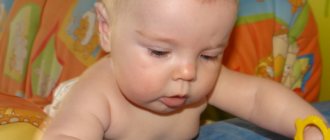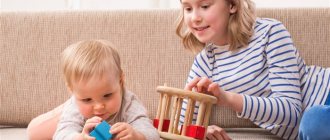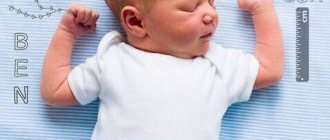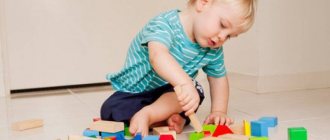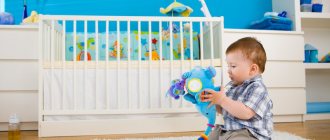Playing together with a child of 7 months is one of the simplest and most enjoyable, but at the same time effective ways to raise and develop a baby. If you choose the right toys and not just give them to your child, but plan interesting activities, you can count on the correct formation of systems and organs, the formation of the psyche and sensory perception of the world, and the rapid sharpening of speech skills and intelligence.
To play with your baby and benefit from it, it is not necessary to purchase educational complexes that are so popular today. It is better to use objects that constantly surround children and do not cause misunderstanding and rejection. You need to work with children (and playing at such a tender age is hard work) every day, touching on all areas of their development.
Stimulating the physical development of a child at 7 months
By the age of seven months, most babies sit confidently. This is a significant achievement, since the baby himself takes the position that he wants at the moment. In addition, many babies are actively learning to crawl, making significant progress. Some children even try to crawl up the stairs if they live in a cottage or multi-story apartment.
Physical and mental activity at this age are closely intertwined, the baby learns:
- consciously control your body;
- change position;
- move in the direction he needs.
Some children at the age of 7 months stand on their own with the help of support (for example, a bed rail or playpen) and stand for a minute or two, looking at the surrounding space.
These new possibilities bring incredible joy to the child himself, so he actively tries to do something else, reaches out with his hands wherever he can reach, takes in his hands and mouth everything that is available to him. Exploring the world by taste and touch is an entertaining process that a 7-month-old baby does as long as he has enough strength.
To develop a child’s physical activity at 7 months and help its further development, you can use games, activities and exercises.
Crawl
An important skill for this age is crawling. To help your baby strengthen this skill or learn, if he is not yet trying to move on all fours, you can stimulate him with interest in the toy.
To do this, the child should be placed on his stomach on a flat, hard surface, and a bright toy should be placed in front of him at a short distance. For the first forward movements, parents can create support for the baby's feet, this will help him move forward.
Having reached the toy, the baby will be delighted with his own skill and achievement of the goal. Next time, the distance between it and the object can be increased. Regular training will definitely give the desired result.
Hide and seek
Hide and seek can be done using a toy. To begin with, you should hide it behind a pillow or behind a chair so that the baby can see where it was placed. The child will try to get to the toy and open its “shelter”. Another time, you can hide it unnoticed, but leave visible some part of the object that will be recognizable to the child. Further complicating the game involves real hide and seek.
Marina, 35 years old, mother of one-year-old Danil: “At six months old, my Danya learned to sit confidently, but has not yet tried to crawl. I thought I could wait until he was ready to crawl and just watched him. And then the pediatrician recommended helping him. I spread a large cotton blanket on the floor, laid it on his stomach and placed a few of his favorite toys around it. We crawled together, every day further and more confidently, and already at 7 months he crawled so fast that sometimes I couldn’t keep up with him. Crawling became his favorite way to move around the apartment.”
seat
Most babies sit well and confidently by the age of seven months, but the process of changing the position from lying down is different for each child. Training the ability to sit down from a lying position is aimed at strengthening the abdominal and arm muscles. To do this, when the child is lying down, you need to place the fingers of an adult in his hands and encourage him to pull himself up and then sit. Each time, reduce the force with which you pull the baby, encouraging him to rise on his own.
Don't forget to praise your child for his successes - this is the best incentive for any achievements.
Ability to maintain balance
This game is liked by all kids without exception. Place the child facing you on your lap, securing him on the sides with your hands. Slowly rock your baby from side to side, encouraging you to maintain balance. Read the poem:
We drove and drove to the city for nuts, over bumps, over bumps, and into a hole - bang!
We try to get up
You will need a high chair with a backrest. Tilt it so that the baby, standing on all fours, grabs the backrest. Pull the chair towards you so that the child first stands on his knees and then on his feet. You may have to press your baby's feet to the floor at first.
Even if everything doesn’t work out right away, don’t despair. By engaging your child, you can maintain his interest for a long time.
Take it and then give it away
It is necessary to prepare a basket with household items that are safe for children. You can put brushes, sponges, plastic cups, wooden spoons, and rattles in it.
The parent places the basket between himself and the child and takes one item out of it. He names it and offers the baby to take it: “Look, this is a spoon. Hold the spoon." If he takes it from your hand, you should encourage it. The baby must study the object a little before the parent asks him back: “Please give me the spoon.” If he gave, then you need to thank and praise. But the baby can keep the item, then you just need to offer the second item from the basket, and ask to give the first one when he has already played with it.
Over time, you can ask the child to take a specific item from the basket by name. If the baby finds things incorrectly, then you should name the item that he gives and thank you.
Games and activities for the emotional development of a child at 7 months
An important feature of a baby’s emotional development by the age of seven months is attachment to loved ones. Usually it is aimed at one person - most often the mother, who spends most of the time with the baby. Although the child already recognizes other family members, reacting to their appearance with a smile and joyful hum.
Attachment to the mother can be expressed by positive emotions when he looks at her and even tries to “communicate”, and by negative manifestations when the baby cries or resists even a short separation.
At the age of 7 months, the baby is actively exploring the world around him, he has favorite objects, toys, activities, and his own preferences. This can be seen by his reaction to this or that thing. For example, if the mother begins to pack the baby for a walk, he reacts violently to getting dressed - he joyfully anticipates going out, or vice versa, he screams not wanting to get dressed.
Dressing
To distract your baby from getting dressed, smile so he can see your friendly face. While dressing, say:
"Give me a pen. Give me another one. And now a leg - one and the other! We'll put socks on our feet and a hat on our heads. Like this!".
When you dress your baby, hug and kiss him and say: “That's it, we're dressed!” Perhaps the process of dressing will become easier and more enjoyable.
In addition, the child reacts sensitively to the adult’s mood, repeating facial expressions and facial expressions. A 7-month-old baby can distinguish the intonations of an adult, especially responding to praise and affectionate words. And even learn to provoke a response from mom or dad, starting to cry or, conversely, smiling and babbling.
Educational games for 7-month-old children, aimed at stimulating the emotional component, should be carried out constantly and regularly. Over time, the child will develop favorite activities that he will do with special pleasure.
"Stretch"
One of these games is “Polyagushechki”. When waking up after a night's sleep, play with your baby, reading poems and repeating the actions described in them:
Stretching, stretching, They came off the pillow. They lifted their legs, They chatted. They raised their arms, They hugged Mom. They smiled, spun, And fell back!
The most common and favorite games for a 7-month-old baby are “Magpie-Crow”, “Ladushki” and “Peek-a-boo”. All children, without exception, love to play the latter, watching how mother hides behind her own hands or a scarf, and then emerges from there. Over time, the child will also begin to hide his face in his hands and exclaim “peek-a-boo” as he puts them away.
Elena, 29 years old, mother of Nastya, 9 months: “What my daughter and I love most is playing Ladushki.” From the age of six months, I sat her on my lap and began to say a rhyme, repeating with her hands all the movements I spoke about. It became a great joy for me when Nastyusha began clapping her hands at 7 months, and after some time she repeated all the movements herself. We still play this game, it remains her favorite.”
Tactile pad
For this game you will need to sew a small pillowcase with Velcro. Fill it with crumpled paper or old newspapers. You want the pillow to be crispy and rustling.
It is worth inviting the child to play with the pillow, hitting it with his palms. While playing, you need to talk or sing funny children's songs. You can join in patting the pillow, sharing the joy with your baby. It should be shown that blows can be slow or fast, strong or light.
Over time, you can replace the filling of the pillowcase with pieces of soft sponge, polystyrene foam and other filler.
Games and activities for developing intelligence
Understanding the world around us has been and remains the main direction of a child’s development; he is interested in everything and needs to try everything. And with the development of physical activity, the baby will already try to reach or reach the object that interests him.
Therefore, it is important to secure the space in which the child is located and remove all unnecessary or potentially harmful objects.
An important feature of this age of a child is the knowledge of the properties of objects, that is, he will try to roll balls on the hard surface of a table or floor, try to place cubes one on top of the other, and put smaller objects inside the bucket. This is an important skill that can be used in games and help reinforce it.
At seven months, the baby understands much of what adults say. This is reflected in games, when the baby can do what the mother asks, or look in the direction of the object she is talking about. This is also evident in nursery rhymes about magpie-crow or darlings: the child repeats actions that correspond to the words in these rhymes. The more often you conduct such exercises with him, the better he will learn the necessary movements.
The most popular and interesting games for a 7-month-old baby:
"Find a toy"
Among 3-4 objects familiar to the baby, you can ask him to find a ball or a cube. It is important to encourage the child and be sure to praise him for the correct answer.
"Third Toy"
An entertaining educational game in which the baby is given small toys in both hands, and then another one is offered. The child is forced to choose which of two toys to keep in order to take the third. This is a great exercise to develop your thinking.
Collecting small items
To do this, you need to take a bucket and 8-10 walnuts, clothespins or small balls. All small objects are laid out around the child, and the adult asks the child to collect them in a bucket and shows how this is done.
Drawing
Finger painting and plasticine modeling are great activities for fine motor skills. It is important to choose materials that are safe for your child and ensure that he does not put them in his mouth.
Puppet or finger theater
You just need to buy a few toys that fit on an adult's hand or fingers, and you can open up your child to a whole new world of talking characters.
Playing with a 7-month-old child can be done with the help of improvised objects, which will be no less interesting for the baby than toys bought in a store. The presence of loving parents and their active participation in his games is important for the baby.
Hi Bye
You need to take your child’s favorite soft toy: a bear, a bunny or someone else. The parent holds the toy behind his back, and then shows it to the child and says: “Hello, bear!” Then he waves his hand in a “hello” gesture, asking the child to wave too. If the baby doesn’t know how yet, you can take his hand in yours and wave it.
You need to let the child play with the toy, and after a while say: “Bye, bear!” Also wave the “bye” gesture, if the child waves to the bear cub too, he should be encouraged. When the baby does not wave, you need to take his hand and wave the “bye” gesture together. Then put the toy behind your back again to pull it out and say “hello” again.
You can show your child how to hug the teddy bear after greeting him. And also, after finishing the game, put the toy in the crib and cover it with a blanket, saying: “Sleep sweetly, bear.”
Games for the development and understanding of speech
To the question “Where?” At 7 months, the baby can look for objects that are constantly in the same place. It is important to expand the child’s vocabulary by naming and showing as many objects from the surrounding space as possible.
"Watch"
Any wall clock is suitable for the game. Bring the baby closer to the clock, saying:
Listen, look, how my clock goes. The clock goes like this: Tick-tock, tick-tock. Where, where is my clock? Here it is, my clock! The clock goes like this: Tick-tock, tick-tock.
In order for the baby to begin to understand speech, you need to actively show and pronounce all the movements. Rhymes are very suitable for this; kids like their tact.
"The Ghouls Have Arrived"
Place your baby on your lap. Take the child's hands in yours and depict the actions:
Ay, lyuli, lyuli, the ghouls flew in (waving the baby’s arms like wings) flew in, flew in and sat down on the head (place your hands on the child’s head). You, my baby, Wave your palm (wave your palm) Shoo, goo, shoo! Shoo, shoo, shoo!
Bubble
Blow some soap bubbles and show your child how they burst. The baby should be encouraged to try to reach the bubbles with his hands or even crawl towards them. You can shoot bubbles as long as he likes this game.
It is important to be careful not to get the bubbles into your child's eyes.
Educational toys for a 7 month old baby
A large number of toys will distract the baby and lose value, but a few of the most interesting, favorite and captivating ones will help the child’s development. Therefore, you should not buy new toys every week.
As writer Esther Selsdon once noted, “If you want to raise good children, spend half as much money and twice as much time on them.”
A variety of children's products allows you to choose any toys for a seven-month-old baby according to the wishes and capabilities of the parents. The most useful and common educational toys from 7 months are:
Pyramid
It can be soft, plastic or wood. The child will be happy to look at the bright details of the pyramid and learn to form their correct sequence.
Sorter toy
The sorter can be a regular box with holes for different shapes, or it can be made in the form of a musical machine with different functions. What exactly to choose is up to the parents to decide.
Tumbler dolls
Tumblers will arouse great interest in a 7 month old baby, especially if they make sounds or melodies when rolling.
Yula
It fascinates children, even if they are not yet able to start it on their own.
Books
Books with bright pictures and thick pages. Joint reading with the mother should begin from the very birth of the child, and during the formation of the speech apparatus is of particular importance.
Thus, games and toys for a child aged 7 months represent a vast field of activity and exploration of the surrounding world. By using imagination and regularly devoting time to their baby, parents can significantly influence his development and perception of objects.
Let's Dance
The parent turns on cheerful music, takes the baby in his arms and starts dancing. It is important that eye contact is made with him. Many children love to be swung in their arms and lifted up to the rhythm of the melody.
You can dance with your child while sitting: hold him by the arms, swaying to the beat of the melody.


